Hypersonics benefit from computational efficiencies
By Dushhyanth Rajaram|December 2022
The Non-Deterministic Approaches Technical Committee advances the art, science and cross-cutting technologies required to advance aerospace systems with non-deterministic approaches.
Hypersonics has been an exciting field for computational non-deterministic researchers this year as opportunities arose at a rapid pace. Throughout the year, the U.S. Department of Defense’s Joint Hypersonics Transition Office worked with industry and academia on the 2022 research topics announced in October 2021. These topics — cooperative engagement and jet dynamics and control — were aimed at solving unique challenges encountered by hypersonic aircraft related to high sensitivities that demand rapid and precise system inputs to control. Non-deterministic approaches leveraging machine learning, uncertainty quantification and optimization methods are crucial for understanding the variability in hypersonic systems and its potential consequences.
Non-deterministic methods played a key role in developing procedures in determining the specific limits of materials, or design allowables. In July, the Metallic Materials Properties Development and Standardization General Coordination Committee with Battelle Memorial Institute of Ohio released the MMPDS-17 repository, providing the most up-to-date procedures for developing statistically based basis values for metallic materials.
In February, researchers from MIT, the Naval Postgraduate School, the University of California at San Diego and the University of Texas at Austin introduced two notions of certifiability for risk-based engineering design optimization. Reliable, risk-averse engineering requires formulating optimization problems that can capture risks associated with unwanted system behavior under uncertainties. These notions can certify designs against near-failure and catastrophic failure events and enhance optimization convergence through preserving underlying convexity. The research gave practitioners alternatives to classical reliability-based design optimization.
In May, researchers from New York University introduced a computationally efficient non-deterministic multifidelity method that enables solving large-scale, nonsmooth optimization problems with many variables. This approach helps in solving problems that arise when designing controllers that stabilize systems under disturbances and noise and is essential for ensuring safe and reliable operations. The method achieved computational efficiency by relying on lower-fidelity models without sacrificing convergence guarantees.
Argonne National Laboratory of Illinois, GE Research of New York, Edison Welding Institute of Ohio and GKN Aerospace of the U.K. won an award from the U.S. Department of Energy’s Advanced Manufacturing Office to develop a framework called PRISM, or Probabilistic Machine Learning for Rapid Large-Scale and High-Rate Aerostructure Manufacturing. The goal is to improve manufacturing efficiency for large-scale aerostructures that are produced at high rates.
In June, researchers in the probabilistic design team at GE Research received the best paper award at the American Society of Mechanical Engineers Turbo Expo Conference for “A Probabilistic Machine Learning Framework for Explicit Inverse Design of Industrial Gas Turbine Blades.” They also received best paper award for “Reinforcement Learning-Based Sequential Batch-Sampling for Bayesian Optimal Experimental Design” at ASME’s International Design Engineering Technical Conference in August.
Throughout the year under the European Commission-funded Stardust Reloaded project, researchers at the University of Strathclyde’s Aerospace Centre of Excellence, or ACE, in Scotland developed techniques for long-term tracking of space objects in the presence of multiple sources of uncertainties and disturbances. Their hybrid approach relies on a numerical model for translational motion and a closed-form analytical solution to approximate the attitude motion. Their method achieved a good balance between efficiency and accuracy for long-term propagation of space objects.
Throughout the year, a consortium led by ACE demonstrated a digital twin of a large drone network with drones, ground infrastructure and payloads to model and simulate a proposed delivery network of medical supplies throughout Scotland. The CAELUS project, short for Care and Equity — Logistics UAS Scotland, in July received 10.1 million pounds ($11.95 million) from the U.K. government to begin the next phase of flight trials.
Contributors: Sifeng Bi, Anirban Chaudhuri, Sayan Ghosh, Boris Kramer, Andrew Ollikainen and Benjamin Peherstorfer



































